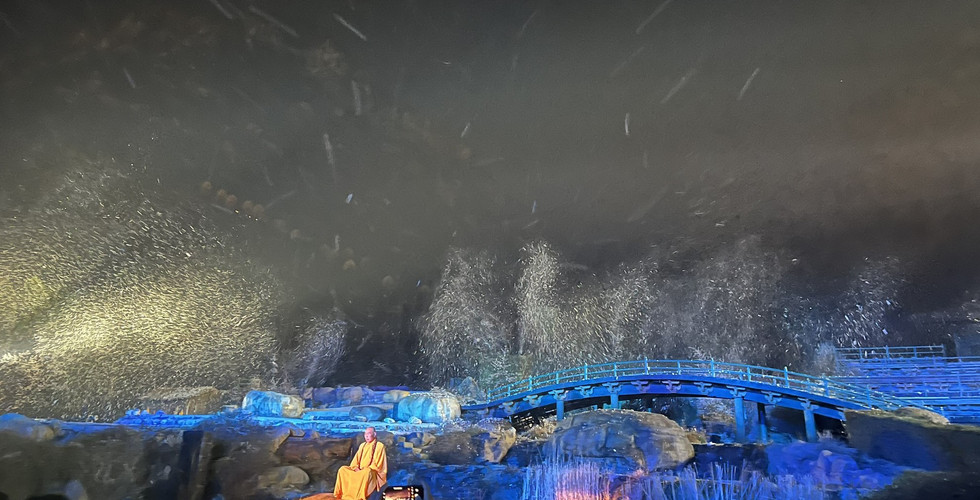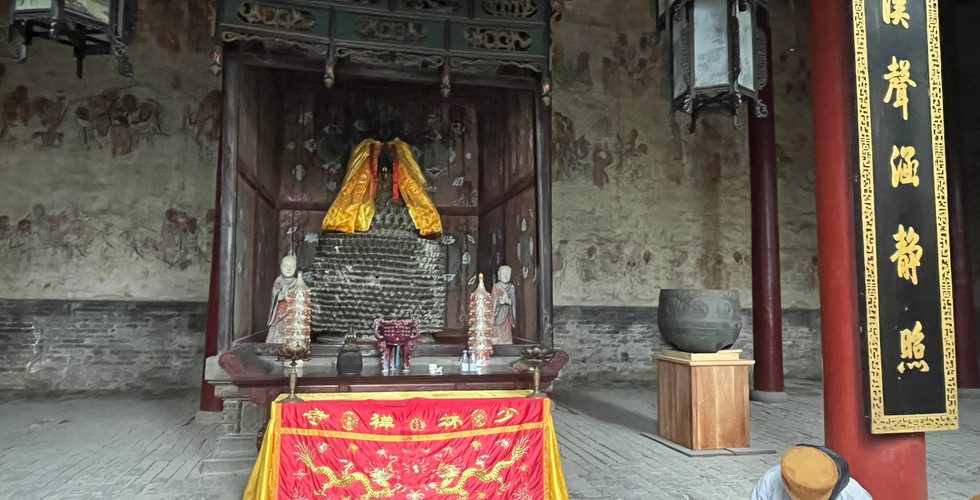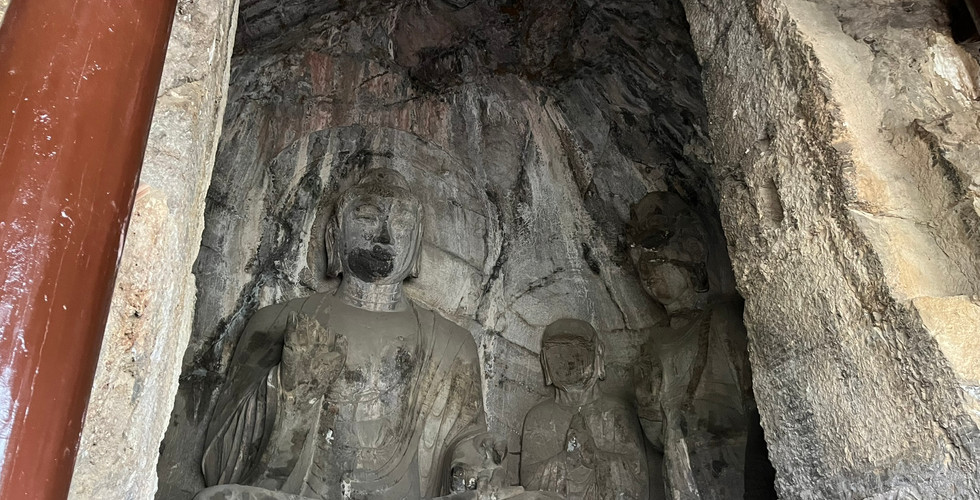Shaolin Temple – The heart of Chan Buddhism and Shaolin Kung Fu
- Cristina Dwyer

- Dec 5, 2024
- 6 min read
Updated: Jan 2
A few years ago, I attended a Shaolin Kung Fu demonstration show in Vancouver, Canada. From a distance, I watched hundreds of monks move with such grace and agility, they looked more like acrobats than fighters. It was hard to believe that these were real, deadly techniques. Fast forward to late March of this year, and I found myself on the very land where Shaolin Kung Fu was born – I went on a three-day tour organized by Shanghai Expatriate Association, an organization I joined last year and currently volunteer for. This time, I was in for a much closer look at the real deal.
The trip, whose main attractions were the Shaolin Temple and the Songshan Mountain, took me into a world so much different from the buzzing Shanghai and Hong Kong metropolises that I had experienced up until then. I got transported into China’s ancient history, spirituality, and traditions, where centuries-old temples, guarded by mist-covered mountains, still hold their ground in the modern age.
Getting there wasn’t quite a walk in the park though. We flew into Zhengzhou (a 2-hour flight from Shanghai) and then hopped on a coach for a nearly 2-hour drive to Dengfeng, where we set up base. For the next few days, we cruised by coach among the different touristic sites, each one a good distance apart.
In the evening of our arrival, we attended the Shaolin Zen Music Ritual, an open-air performance that blended the music and dance with martial arts techniques demonstrated by 600 Shaolin monks.
The show stage was set in a gorge with the Songshan Mountain in the background; the lighting effects were spectacular, (they even made the moon show up) while the music created an atmosphere that aimed to bring us into the story telling of the everyday life of people, with their joy and hardship, throughout different seasons. During the entire 90-minute show two older monks sat still in a meditative stance, quite a performance in itself.
We started our second day bright and early to make the most of our packed schedule.
Our first stop was the Zhongyue Taoist Temple. Built during the Qin Dynasty (221-207 BCE), the temple is the greatest well preserved ancient architectural complex in China.
It was raining lightly when we got there, a drizzle that stayed with us for the whole day. I didn’t mind it, I love the rain mist; while there, it seemed to be laying an aura of mysticism over the whole area.
The temple, though rather simple in appearance, radiated strength, stability, much like the surrounding mountains. Its structures are old, but perhaps its spirit renews each year, just like its gardens. It felt very much alive to me. Our group scattered, wondering around alone or in pairs; we didn’t talk much, the quietness of the space was inviting to introspection and reflection. I think each of us left with a personal takeaway from that visit, I certainly did.
Our second stop was the Shaolin Pagoda Forest, a UNESCO World Heritage site.
Typically, when I would hear "pagoda," I picture a towering, multi-tiered building with those classic upturned roofs. Well, it was not the case here. These pagodas were smaller, made of stone, and served a very different purpose - they are tombs for high-ranking Shaolin monks. The higher the rank, the taller the pagoda.
Nestled in an actual forest, near the Shaolin Temple, the "Pagoda Forest" is essentially a sacred cemetery. Its design makes you feel like you're walking through a forest of stone trees – solemn, maybe a bit intimidating, certainly very serene.
Next, we went up Songshan Mountain whose shadow we had a glimpse of on the very first night. Just to be clear, we didn’t climb it, we took a cable car up to a scenic spot ( I believe it was San Huang Zhai) with the plan to walk along the breathtaking path clinging to the mountain’s edge.
The early rain mist that I love so much (it reminds me of Canada’s West Coast) decided to show up as a persistent rain and a thick fog up there, leaving us to imagine what the view might have been. On the bright side, the weather did scare most visitors, so we had the place practically to ourselves - peaceful and mysterious. I'm also sure it was a good day for the street vendors of water repellent ponchos and umbrellas.
Songshan Mountain, as one of China’s five great mountains, has been celebrated for centuries in literature, folk traditions, and even Chinese astronomical mythology. This sacred peak is quite special - it is the birthplace of Chan (Zen) Buddhism, famously represented by the Shaolin Temple, its superhuman kung fu monks, and their ancient traditions of medicine.
The Shaolin Temple, a UNESCO World Heritage Site, is, unsurprisingly, missing rich adornments. However its architecture is rich with subtle details that reward those who take the time to notice. Hundred-year-old trees stand as witnesses to kung fu training exercises (referring to the holes in one of the pics), just like some of the stone floors, worn and dented by generations of monks practicing their craft. The air seemed to be thick with a sense of resilience, as though the monks’ spiritual strength and physical agility lingered in every corner.
We ended the day with a Shaolin Kung Fu demonstration at the Shaolin Temple Wushu Training Centre. While there was a touch of staging to keep things entertaining, the skill on display was 100% real. One act stood out for me: a monk throwing a needle at a 1ft x 1ft glass pane aiming to puncture the glass and pop a balloon placed just behind it, touching the glass. After three failed attempts by one monk, and two more by a more experienced one, the impossible happened - the balloon popped! I managed to catch it in my video, check it out !
It was a long but rewarding day. The less-than-ideal weather made it a bit more tiring, so the perspective of coming back to a comfortable hotel and a delicious dinner felt really good.
One thing I’ve learned in China is that private dining rooms for groups or families are pretty standard. They offer privacy and sometimes come with quite an elaborate décor. The meals are always served family-style, where shared dishes are laid or even stacked on a big ‘lazy Susan’ spinning at the center of the table. It is a practical serving style which sometimes turns into a silent competition for snagging the desired dish before it rotates out of reach; you need to focus!
The morning of our third and final day brought us closer to the everyday life of kung fu students. We visited one of the 60 martial arts schools where kids, aged 7 to 18, live and learn both academic subjects and martial arts. Their routine is strict: daily training, cell phone use limited to weekends, doing their laundry by hand. It’s a lifestyle designed to teach self-sufficiency and discipline. Despite the seemingly rigid upbringing, the atmosphere within the boxy quarters was surprisingly joyful. The kids were ... just being kids, spending time together, perhaps playing pranks to each other, a little shy and curious about us, visitors. A few the “older” students (15 to 17-year-olds) demonstrated their skills and got to teach us a few moves.
Last but certainly not least, we visited the Longmen Grottoes, a UNESCO World Heritage Site near Luoyang and a stunning testament to the Chinese Buddhist art. Carved into the limestone cliffs along the Yi River, the grottoes house tens of thousands of Buddha statues in various sizes, along with countless inscriptions. For centuries, this site has served as a place of meditation and prayer for both commoners and royalty, especially during the Tang dynasty.
As I wandered around, I couldn’t help but reflect on the striking duality of the experience. On one hand you need to be up close to appreciate the intricate details of the sculptures and, on another hand, you need to step way back, to appreciate the sheer scale of the artwork. It’s a balance that I felt reflected the Buddhist teachings - seeing the small and the vast, the personal and the universal.
It has been nearly a decade since I last joined a group tour and, I’ll admit, I was a bit skeptical about doing it in China. Questions ran through my mind: “Will we see the real stuff? How authentic will the experience feel? Will I get any alone time to truly take in the places we visit?” Surprisingly, the balance was just right. While group trips require a set schedule and itinerary, I still had plenty of ‘me’ time to wander off, reflect, or simply take it all in at my own pace. At the same time, I got to enjoy the company of like-minded travelers and connect over shared experiences.
The best part? Not having to stress about logistics. I just showed up, explored, and even got a bit of VIP treatment in certain spots, courtesy of our organizers. It was a memorable trip that reminded me that group travel can also be a great way to scout out for new places.



































































































































































Beautifully written! I felt like I was there!
Another awesome post. Where are you going next?
Cristina another excellent blog and managed to view the videos as well. Walking on that rainy day on the edge of a cliff...I can just imagine coming back to the hotel what a relief it would have been!
Loved that first photo - just gorgeous!
Seriously interesting as this is not anything close to what I have experienced. So much in the world. Thank you so much for sharing!